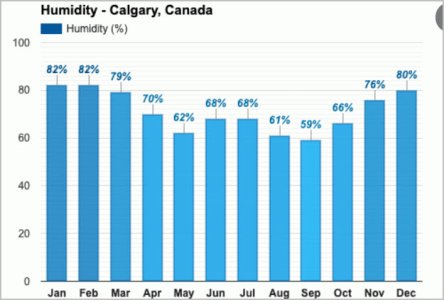I feel your pain. Essex/Kent is usually over 90% because it is the south-most part of Canada at the same Latitude as the north border of California and surrounded by huge lakes and I live right on the North shore of Lake Erie. But it can get worse -
@whydontu has salt in his air!
I promised a little more research. I dug out my psychometric charts again and made the following chart that shows the data in a little more useful format. This is the MAXIMUM water that air can hold at the temperatures listed - ie at 100% humidity.
I figured per 1000 ft3 and per 100m3 were pretty reasonable multiples for most shops and garages.
For example, if I assume your garage is 20x20 with 10ft ceilings, that is 4000 ft3. Per the chart, 30°C air can hold 1L of water per 1000ft3. Therefore, the 4000 ft3 of air in your garage can hold 4x that or a maximum of 4L of water.
% Relative Humidity is a term that was developed to describe how much water there is in the air compared to how much water CAN be in the air. For example, if the air in your garage can hold 4L of water, then at 75% humidity, the air is holding 3L of water and at 50% relative humidity it is holding a total of 2L of water.
One look at the maximum water content at temperatures below zero VS temperatures above 20 (winter VS summer) and it becomes easy to see why homes need to add water in the winter and dehumidify in summer. When that low water winter air gets into your house and then gets warmed up, the relative humidity DIVES!!!!
The reason that rust forms in humid air is also evident in the chart. For example, let's say the temperature is 30°C and the relative humidity is 90% inside your 4000ft3 area. Then let's say the temperature overnight drops to 20°C. From the chart 1000 ft3 of 30 degree air CAN hold 1L of water. At 90% relative humidity it is actually holding 90% of 1 L which is 0.9L. However, at 20 degrees, that same air can only hold 0.6L of water. For 4000ft3, it's 4 times that or 3.6L and 2.4L. As a result, 1.2L of water MUST condense out of the air by forming dew on everything in the garage. Rust is inevitable. When people talk about the dew point, they are referring to the temperature at which the relative humidity reaches 100% based on the amount of water in the air before it started cooling.
It's important to recognize that you cannot go by how much water your bucket accumulates in the first week of its use. Wet concrete, absorbant materials, dampness, and other water sources in your garage can add up to a LOT more water than there is in the air. As the air dries out, all that absorbed water starts to dry out too. That's probably why your pail filled so fast at first.
The good news is that the air will dry out those areas once it is dry enough itself to be able to do that. It appears to be doing that already, but you can expect the overall process to take a week or so.
After that, you should actually be able to use the amount of ongoing water removal as a proxy for how much your garage is leaking air. In the process of doing that, don't underestimate how much air gets changed every time you open a door or run that exhaust fan. That said, your Dehumidifier should work much faster and better once the garage itself is dried out. A little internal air circulation will help too.
Although the data is definitely not linear, it is still reasonable to use standard linear interpolation to determine the maximum water contained at other temperatures not listed in the chart.
I hope all that is useful to
@combustable herbage and you and others. I'm annoyed with my progress on my Hartford Mill right now, so I really needed a good distraction and this was perfect!


